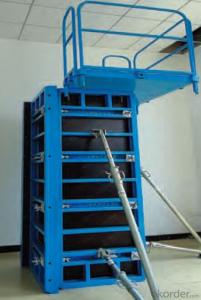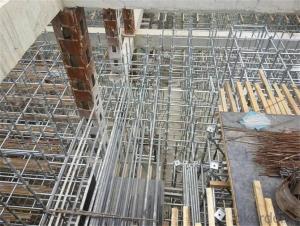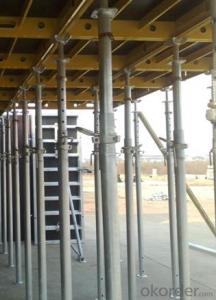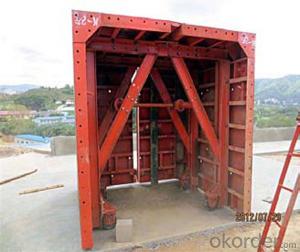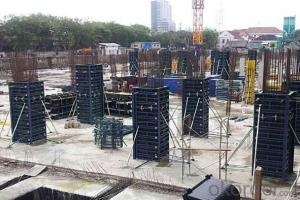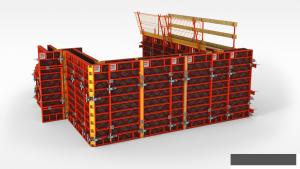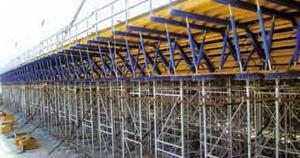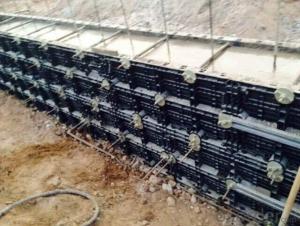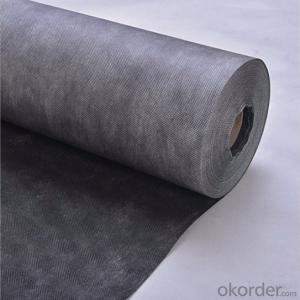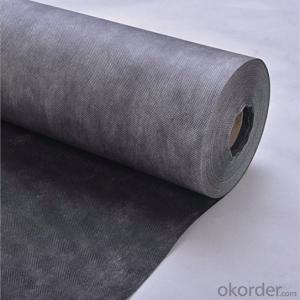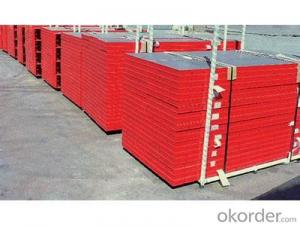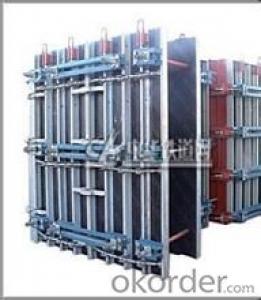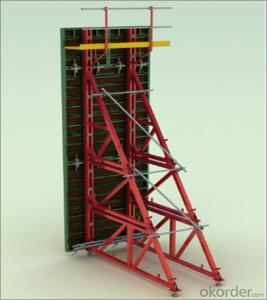Steel Fram Formworks Used for Building Constructions
- Loading Port:
- Shanghai
- Payment Terms:
- TT OR LC
- Min Order Qty:
- 1 m²
- Supply Capability:
- 100000 m²/month
OKorder Service Pledge
OKorder Financial Service
You Might Also Like
1. Structure of Steel Frame Formwork GK120 Description
There is a prizing part designed in the corner, which can help to position and remove formwork easily.The plywood is screwed on from the back when connecting frame and plywood, so the surface of the finished concrete is perfect.The formwork series are a complete system with a full set of accessories, and can be set up flexibly according to project demand.
2. Main Features of Steel Frame Formwork GK120
-convenient for construction
-easy to control the quality
-easy, rapid and economical.
3. Steel Frame Formwork GK120 Images
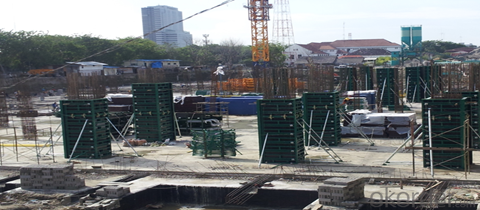
4. Steel Frame Formwork GK120Specifications
Steel Frame Formwork GK120 is used for the concrete pouring of square or rectangle column. The system has the same structure and similar connection type with wall formwork.
5.Steel Frame Formwork GK120
1) What can we do for you?
.We can ensure the quality of the Steel Frame Formwork GK120 and avoid extra expenses for customers.
.We can provide you the professional technical team.
.We can provide professional building proposal for your projects.
2) What promises can be done by us?
. If interested in this kind of formwork, please feel free to write us for any QUOTE.
. If need any technical and building assistance, we could provide on-site professional staff for instruction.
. Please DO check goods when courier knocks your door and contact us asap if any issueS.
3) What about of our after-sale services?
. Response will be carried out in 24hours after receiving any complain or request.
. Any formwork cost can be refund after order is confirmed.
. If the products are not based on the requirements, there will be the relevant compensations made for you.
4) What about the package and shipping time?
.Packing: wood package and adhesive tape
.Shipping: by sea
Shipping time: Normally small orders, it just1week business days to arrive your hand; When comes to the customs declaration, it may need 2weeks.
- Q:What are the safety precautions for storing steel frame formwork?
- The safety precautions for storing steel frame formwork include ensuring the frames are properly stacked and secured to prevent them from toppling over, storing them in a designated area away from high traffic zones, keeping them protected from weather elements to prevent rust and corrosion, inspecting them regularly for any damage or defects, and following any specific manufacturer guidelines for storage.
- Q:What are the different methods of concrete pouring with steel frame formwork?
- There are several methods of concrete pouring with steel frame formwork, including traditional pouring, slip form pouring, and precast pouring. Traditional pouring involves placing the formwork and reinforcing steel, then pouring the concrete into the formwork and allowing it to cure. Slip form pouring is a continuous process where the formwork moves vertically as the concrete is poured, creating a continuous wall or structure. Precast pouring involves precasting concrete elements off-site and then assembling them using steel frame formwork on-site.
- Q:Can steel frame formwork be customized to fit different shapes and sizes?
- Certainly! Steel frame formwork has the capability to be tailored to suit a variety of shapes and sizes. Its versatility is remarkable, as it effortlessly adjusts to cater to diverse construction specifications. This adaptability allows for easy customization to accommodate various dimensions, providing unparalleled flexibility in construction endeavors. This exceptional trait empowers contractors to efficiently erect structures boasting distinctive designs and intricate geometries. Moreover, steel frame formwork guarantees not only a formidable load-bearing capacity but also remarkable durability, thereby ensuring the stability and safety of the structures under construction.
- Q:What are the different types of safety features incorporated in steel frame formwork systems?
- Some of the different types of safety features incorporated in steel frame formwork systems include guardrails, handrails, and toe boards to prevent falls from elevated platforms. Additionally, safety harnesses and lanyards may be used to provide fall protection for workers. Steel frame formwork systems may also have non-slip surfaces to prevent slips and trips, as well as safety locks and pins to ensure stability and prevent accidental collapses.
- Q:How does steel frame formwork handle concrete pouring in earthquake-prone areas?
- Due to its inherent strength and flexibility, steel frame formwork is a highly effective method for managing concrete pouring in earthquake-prone areas. This is because the steel frame provides a strong and sturdy structure that can endure the forces exerted during an earthquake, thus guaranteeing the safety of the concrete pour and the overall stability of the building. An important advantage of steel frame formwork is its capacity to absorb and disperse the energy produced by seismic activity. The steel frame functions as a robust and inflexible support system, evenly distributing the seismic forces throughout the structure. Consequently, this diminishes the impact on the concrete pour and reduces the risk of substantial damage. Moreover, steel frame formwork is designed to be easily adjustable and adaptable, allowing for swift modifications to the formwork system as necessary. This adaptability is crucial in earthquake-prone areas where the ground conditions and the intensity of seismic activity can vary. It guarantees that the formwork can be altered to accommodate any changes or adjustments required during and after an earthquake, without compromising the integrity of the concrete pour. Furthermore, steel frame formwork is highly durable and long-lasting, making it a perfect choice for use in seismic zones. The strength and resilience of steel enable it to withstand the repetitive loading and shaking caused by earthquakes over an extended period. This durability ensures that the steel formwork can endure multiple seismic events, providing a dependable and secure solution for concrete pouring in earthquake-prone areas. In conclusion, steel frame formwork provides a robust and flexible solution for managing concrete pouring in earthquake-prone areas. Its strength, adaptability, and durability make it an excellent choice for handling the seismic forces generated during earthquakes, thus ensuring the safety and stability of the concrete pour and the overall structure.
- Q:What are the common material handling and storage practices for steel frame formwork systems?
- Common material handling and storage practices for steel frame formwork systems involve several key steps to ensure the safety and efficiency of the construction process. Here are some common practices: 1. Proper handling: When handling steel frame formwork systems, it is essential to use appropriate lifting equipment such as cranes or forklifts. These machines should be operated by trained personnel to avoid any accidents or damage to the materials. 2. Storage conditions: Steel frame formwork systems should be stored in a designated area that is clean, dry, and secure. The storage area should be free from any potential hazards, such as excessive heat, moisture, or direct sunlight, which can affect the integrity of the materials. It is also important to store the formwork components in an organized manner to facilitate easy access and prevent damage. 3. Regular inspection: Regular inspection of the steel frame formwork systems is crucial to identify any signs of wear, corrosion, or damage. Inspections should be carried out before, during, and after each use, and any issues should be promptly addressed to ensure the safety and efficiency of the system. 4. Cleaning and maintenance: Proper cleaning and maintenance of the steel frame formwork systems are essential for their longevity and optimal performance. After each use, the formwork components should be cleaned thoroughly to remove any concrete residue or other debris. Additionally, regular maintenance should be performed, including lubrication of moving parts, tightening of fasteners, and repair or replacement of any damaged or worn-out components. 5. Proper stacking and transportation: When storing or transporting steel frame formwork systems, it is important to stack the components properly to prevent any distortion or damage. Components should be stacked in a stable and secure manner, ensuring that the weight is evenly distributed. During transportation, the formwork systems should be adequately secured to prevent any movement or shifting that could lead to accidents or damage. By following these common material handling and storage practices, construction teams can ensure the longevity, safety, and optimal performance of steel frame formwork systems, ultimately contributing to the success of the construction project.
- Q:What are the key considerations for selecting the appropriate steel frame formwork accessories?
- Some key considerations for selecting the appropriate steel frame formwork accessories include the compatibility with the formwork system being used, the desired level of strength and durability, the ease of assembly and disassembly, the ability to accommodate different concrete pouring techniques, the availability of necessary safety features, and the overall cost-effectiveness of the accessories.
- Q:How does steel frame formwork affect the overall durability of a concrete structure?
- Steel frame formwork enhances the overall durability of a concrete structure due to its robustness and resistance to deformation. It provides a rigid framework that supports the weight of wet concrete during pouring and ensures proper alignment and stability. This helps to prevent cracks and structural weaknesses in the concrete, leading to a more durable and long-lasting structure. Moreover, steel formwork is reusable, which reduces construction costs and environmental impact.
- Q:How does steel frame formwork contribute to sustainable construction practices?
- In several ways, sustainable construction practices are enhanced by the use of steel frame formwork. To begin with, steel possesses remarkable durability, enabling it to withstand harsh weather conditions and resist degradation over time. This durability allows for the multiple reuse of steel frame formwork, thereby reducing the frequency of replacements and minimizing waste. The reuse of formwork not only saves costs but also diminishes the consumption of natural resources. Moreover, the versatility of steel frame formwork enables it to be easily adapted and adjusted to various construction projects. This adaptability permits a more efficient utilization of materials, as the formwork can be customized to meet specific project requirements, resulting in a reduction in material waste. Furthermore, steel is a recyclable material, meaning that at the end of its life cycle, the steel frame formwork can be recycled and utilized in the production of new steel products. The recycling of steel diminishes the necessity for mining raw materials and reduces the carbon footprint associated with the manufacturing of new steel. Additionally, steel frame formwork provides a high level of precision and accuracy, resulting in well-finished concrete structures. This reduces the need for additional materials and resources to rectify errors, ultimately reducing waste and improving overall construction quality. Lastly, steel frame formwork is renowned for its strength and stability, enabling the construction of taller and more complex structures. Through the use of steel frame formwork, architects and engineers can design sustainable buildings that optimize space and reduce the need for additional construction materials. In conclusion, steel frame formwork contributes to sustainable construction practices by promoting durability, reusability, recyclability, precision, and efficiency. This ultimately leads to a reduction in waste, the conservation of resources, and a minimized environmental impact in construction projects.
- Q:Are there any specific considerations for using steel frame formwork in coastal areas?
- Yes, there are specific considerations for using steel frame formwork in coastal areas. The primary concern is corrosion due to the high salt content in the air and water. Special corrosion-resistant coatings or stainless steel should be used to prevent the steel frame from deteriorating. Additionally, the formwork should be designed to withstand the strong winds and potential impact from waves or debris in coastal areas. Regular maintenance and inspections are also necessary to ensure the structural integrity of the steel frame formwork in these harsh environments.
1. Manufacturer Overview |
|
|---|---|
| Location | |
| Year Established | |
| Annual Output Value | |
| Main Markets | |
| Company Certifications | |
2. Manufacturer Certificates |
|
|---|---|
| a) Certification Name | |
| Range | |
| Reference | |
| Validity Period | |
3. Manufacturer Capability |
|
|---|---|
| a)Trade Capacity | |
| Nearest Port | |
| Export Percentage | |
| No.of Employees in Trade Department | |
| Language Spoken: | |
| b)Factory Information | |
| Factory Size: | |
| No. of Production Lines | |
| Contract Manufacturing | |
| Product Price Range | |
Send your message to us
Steel Fram Formworks Used for Building Constructions
- Loading Port:
- Shanghai
- Payment Terms:
- TT OR LC
- Min Order Qty:
- 1 m²
- Supply Capability:
- 100000 m²/month
OKorder Service Pledge
OKorder Financial Service
Similar products
New products
Hot products
Hot Searches
Related keywords





